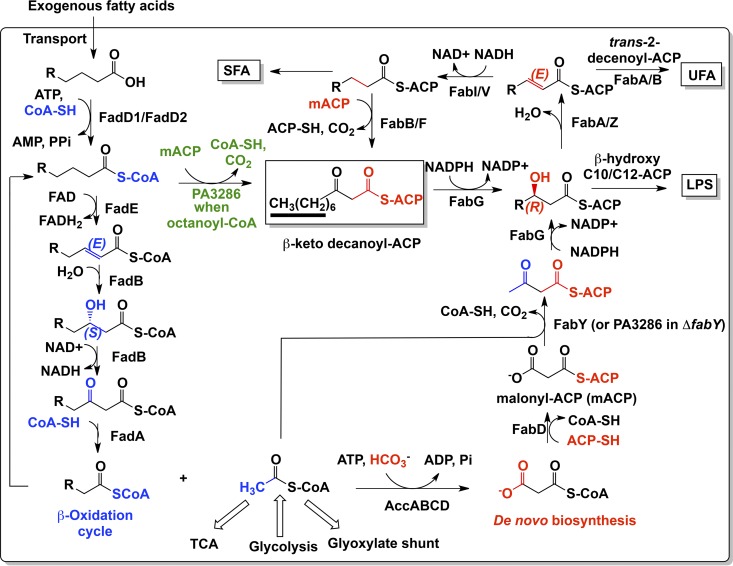Fig 8.
The proposed PA3286-mediated fatty acid β-oxidation to synthesis shunt of P. aeruginosa PAO1. After facilitated diffusion across the outer membrane through FadL (not shown), fatty acids are trapped in the cytoplasm by FadD1/FadD2-catalyzed vectorial esterification with CoA (32). Further metabolism depends on acyl-CoA ester chain length. Long-chain fatty acid CoA esters (C16/C18-CoA) can either be recycled en bloc and incorporated into de novo phospholipids by the glycerol-phosphate and acylglycerol-phosphate acyltransferases PlsB/PlsC (not shown) (60), or as with medium-chain acyl CoA esters (C14 to C10-CoA), be further degraded by the β-oxidation pathway (in blue). Once the preferred C8-CoA substrate chain length is reached, the CoA thioester is intercepted by PA3286 and condensed with malonyl-ACP to form the key uncommitted fatty acid intermediate β-keto-decanoyl-ACP (green). The β-keto-decanoyl-ACP metabolite can be utilized by the anaerobic unsaturated fatty acid (UFA) pathway, the saturated fatty acid (SFA) pathway, and in lipopolysaccharide (LPS) biosynthesis (C10:0/C12:0 3-OH). The terminal 7 carbons in β-keto-decanoyl-ACP that remain labeled with deuterium when fed perdeuterated fatty acids are underlined. PA3286 does not significantly contribute to de novo FAS biosynthesis (in red) (56) but becomes essential in the P. aeruginosa ΔfabY background (Fig. 4B) due to a cellular requirement for basal FabH-type acetyl-CoA:malonyl-ACP condensation activity. For clarity, not all putative FAS and β-oxidation isozymes are shown. TCA, tricarboxylic acid cycle.

